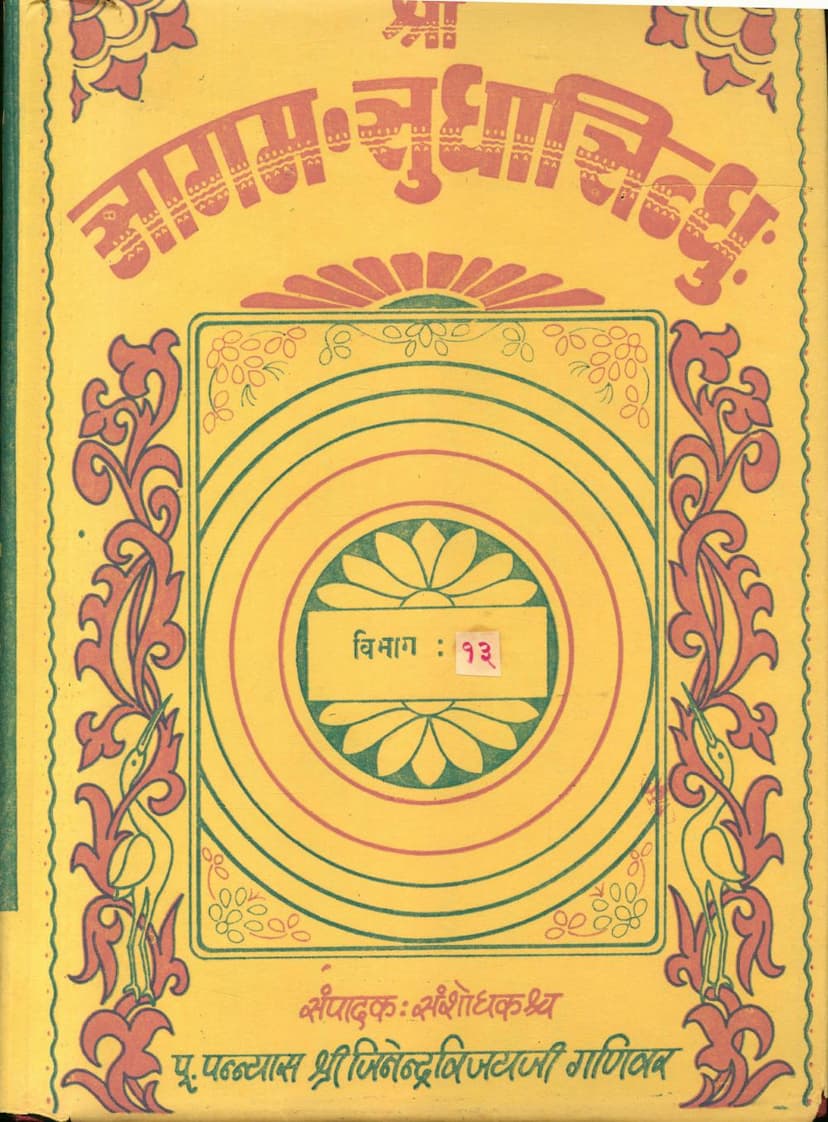Agam Sudha Sindhu Part 13
Added to library: September 1, 2025

Summary
Here's a comprehensive summary of "Agam Sudha Sindhu Part 13" by Jinendravijay Gani, based on the provided text:
Book Title: Agam Sudha Sindhu Part 13 (Also referred to as Trayodashmo Vibhag - Thirteenth Division) Author: Jinendravijay Gani Publisher: Harshpushpamrut Jain Granthmala Catalog Link: https://jainqq.org/explore/004374/1
Overview:
This volume, "Agam Sudha Sindhu Part 13," is the thirteenth part of a larger series aimed at presenting the foundational Jain scriptures (Agamas) in a clear and accessible manner. The series is published by Harshpushpamrut Jain Granthmala. This particular volume is a significant compilation, as it contains three pivotal Agam texts:
- Shri Dashvaikalik Sutra: Composed by Shrimat Shyyambhav Surishwar.
- Shri Pind Niyukti (with Bhashya): Composed by Shrimad Bhadrabahu Swami.
- Shrimad Uttaradhyayan Sutra: Compiled by Shrutsthavir Sandrubdha.
The editor and researcher of this volume is Pujyacharya Shri Jinendravijay Gani. The publication is dedicated to the revered Acharyas Vijay Karpur Surishwarji Maharaj and Shri Vijay Amrut Surishwarji Maharaj.
Key Themes and Content from the Editorial Notes (Pages 4-7):
- The Importance of Jinavani (Sacred Scripture): The editorial emphasizes that Jinavani, comprising the 45 core Agam texts and their accompanying commentaries (Panchangi), is the foundation, lifeblood, and support of the Jain faith. The teachings within the Agamas, like those received by Chilatiputra, guide individuals from a path of downfall to progress.
- The "Panchangi" of Jinavani: The Agamas are understood in their five parts: Mul Sutra, Niyukti, Bhashya, Churni, and Tikas. These are considered essential for the practice of Jainism.
- The Four Pillars of Jainism: The current practice of Jainism is based on the fivefold disciplines (Jnana, Darshan, Charitra, Tap, and Virya). The purity of right faith, right knowledge, and right conduct leads to a bright progression in these disciplines, ultimately illuminating the Jain path.
- The 45 Agam Sutras: The editorial mentions that there are 45 primary Agam Sutras, divided into six categories: Angas (11), Upangas (12), Pad Fannas (10), Chhed Sutras (6), Mul Sutras (4), and Chulika Sutras (2).
- The Rationale for the Series: The series aims to present these 45 Agam Sutras in a continuous and easily accessible printed format, as they are not fully printed together in the Shvetambar Murtipujak tradition. This effort is to facilitate the study and understanding of the Agamas.
- Specific Structure of Part 13: This thirteenth volume specifically includes the Dashvaikalik Sutra, Pind Niyukti with Bhashya, and Uttaradhyayan Sutra. The Pind Niyukti is noted as a Niyukti on the fifth chapter of the Dashvaikalik Sutra and is considered significant enough to be counted as an independent scripture.
- Sources Used: The editing process utilized valuable resources such as "Shri Agama Manjusha" (revised by Acharya Sagar Anand Surishwarji), commentaries published by Babu Dhanpat Singhji, Haribhadriya Tikas, Churni, and other scholarly works from esteemed publications and scholars.
- Purpose of the Publication: The publication aims to assist monks and nuns in memorizing, studying, and reciting the Agamas. It is hoped that this will lead to a deeper understanding and practice of the Agamic knowledge, benefiting the entire Jain community and promoting the glory of the Jain Shasan.
- Correction and Refinement: A "Shuddhupatraka" (errata) is provided to address printing and textual errors, indicating a commitment to accuracy.
Content of the Volume (Pages 9-76 onwards):
The bulk of the volume is dedicated to the texts themselves, presented in Sanskrit and Prakrit, with Gujarati editorial elements.
- Shri Dashvaikalik Sutra: The text begins with the first chapter, "Shri Drum Pushpika," followed by "Shrimanya Shramanyapurva," "Shrimad Kshipra Achara," "Shrimad Shaddjeev Nikaya," and "Shrimad Pindeshana," covering various aspects of ascetic conduct, ethical principles, and philosophical concepts. The Prakrit text is presented with verses and chapters clearly marked.
- Shri Pind Niyukti: This section follows, elaborating on the principles of "Pindeshana" (seeking alms) and related rules and regulations for Jain ascetics, as detailed in the Niyukti.
- Shrimad Uttaradhyayan Sutra: This is a comprehensive text covering a wide range of Jain doctrines, ethics, philosophy, and practical guidance for ascetics. It is divided into 36 chapters (adhyan), each addressing different aspects of spiritual practice and understanding. Topics include:
- Vinaya Shruta: The importance of humility and respect.
- Parishaha: Enduring hardships.
- Chara-Angiya: Conduct related to movement and behavior.
- Pramada-Apramada: Carelessness vs. mindfulness.
- Akama Araniya: Unfulfilled desires.
- Kshulla Nirgranthiya: The conduct of minor ascetics.
- Aura-bhiya: Belonging to the Aurabhra lineage.
- Shravaka-Shruta: Ascetic principles for followers.
- Dharmakatha: Narratives that impart religious teachings.
- And many other crucial topics related to the path of liberation.
Overall Significance:
"Agam Sudha Sindhu Part 13" is a valuable contribution to Jain literature, making these essential Agam texts accessible for study and practice. It reflects the dedication of the author, editor, and publisher in preserving and propagating the profound teachings of Jainism. The volume serves as a resource for monks, scholars, and devoted lay followers seeking to deepen their understanding of the Jain path.